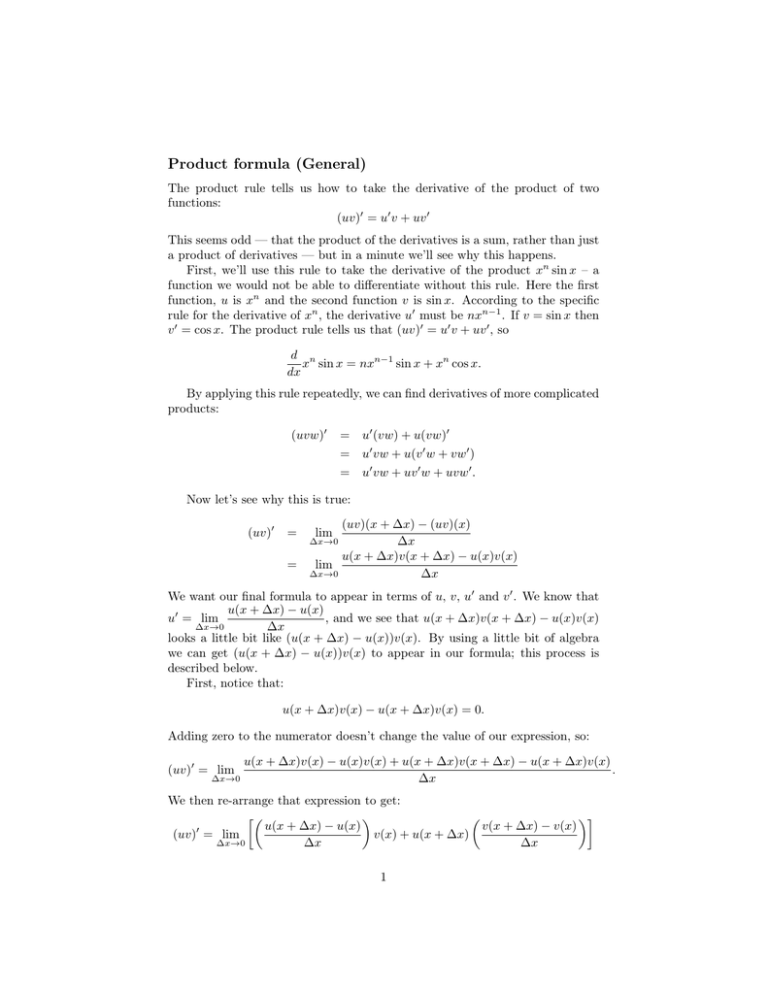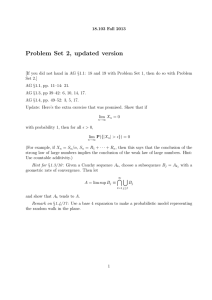Product formula (General)
advertisement

Product formula (General) The product rule tells us how to take the derivative of the product of two functions: (uv)� = u� v + uv � This seems odd — that the product of the derivatives is a sum, rather than just a product of derivatives — but in a minute we’ll see why this happens. First, we’ll use this rule to take the derivative of the product xn sin x – a function we would not be able to differentiate without this rule. Here the first function, u is xn and the second function v is sin x. According to the specific rule for the derivative of xn , the derivative u� must be nxn−1 . If v = sin x then v � = cos x. The product rule tells us that (uv)� = u� v + uv � , so d n x sin x = nxn−1 sin x + xn cos x. dx By applying this rule repeatedly, we can find derivatives of more complicated products: (uvw)� = = = u� (vw) + u(vw)� u� vw + u(v � w + vw� ) u� vw + uv � w + uvw� . Now let’s see why this is true: (uv)� = = (uv)(x + Δx) − (uv)(x) Δx u(x + Δx)v(x + Δx) − u(x)v(x) lim Δx→0 Δx lim Δx→0 We want our final formula to appear in terms of u, v, u� and v � . We know that u(x + Δx) − u(x) , and we see that u(x + Δx)v(x + Δx) − u(x)v(x) u� = lim Δx→0 Δx looks a little bit like (u(x + Δx) − u(x))v(x). By using a little bit of algebra we can get (u(x + Δx) − u(x))v(x) to appear in our formula; this process is described below. First, notice that: u(x + Δx)v(x) − u(x + Δx)v(x) = 0. Adding zero to the numerator doesn’t change the value of our expression, so: (uv)� = lim Δx→0 u(x + Δx)v(x) − u(x)v(x) + u(x + Δx)v(x + Δx) − u(x + Δx)v(x) . Δx We then re-arrange that expression to get: �� � � �� u(x + Δx) − u(x) v(x + Δx) − v(x) � (uv) = lim v(x) + u(x + Δx) Δx→0 Δx Δx 1 We proved that if u and v are differentiable they must be continuous, so the limit of the sum is the sum of the limits: � � � � �� u(x + Δx) − u(x) v(x + Δx) − v(x) lim v(x) + lim u(x + Δx) Δx→0 Δx→0 Δx Δx or in other words, (uv)� = u� (x)v(x) + u(x)v � (x). Note: we also used the fact that: lim u(x + Δx) = u(x), Δx→0 which is true because u is differentiable and therefore continuous. 2 MIT OpenCourseWare http://ocw.mit.edu 18.01SC Single Variable Calculus�� Fall 2010 �� For information about citing these materials or our Terms of Use, visit: http://ocw.mit.edu/terms.






